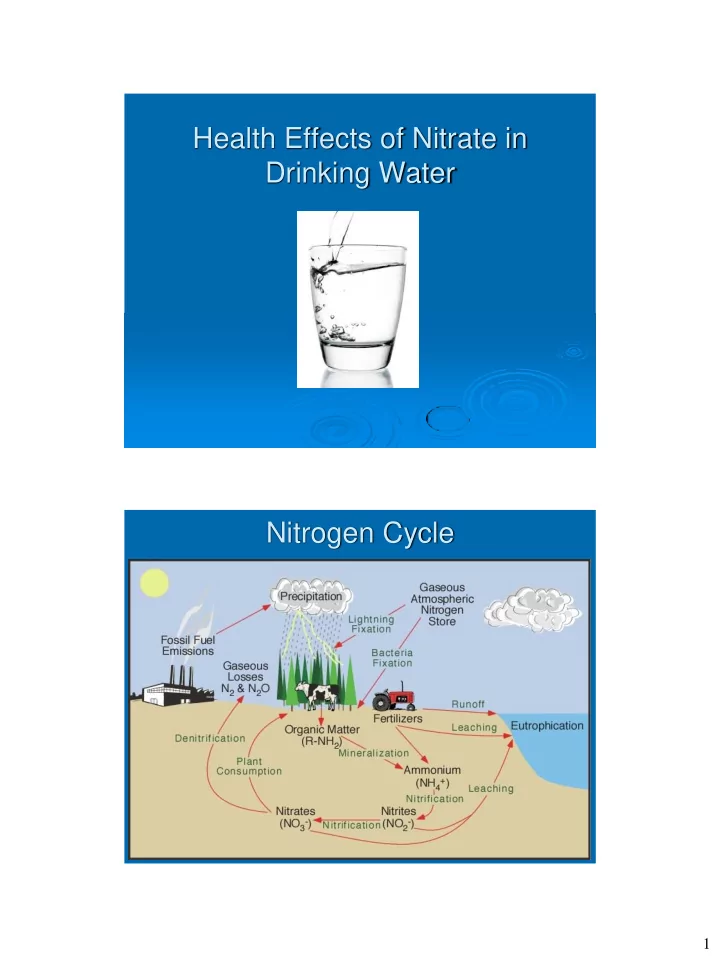

Health Effects of Nitrate in Drinking Water Nitrogen Cycle 1
Possible Health Risks by Level of Nitrate Adapted from University of Idaho Extension Source: http://www.cals.uidaho.edu/edcomm/pdf/CIS/CIS0872.pdf Methemoglobinemia Nitrates and blue baby syndrome 2
Nitrate in Methemoglobin drinking water (Fe +3 ) Blood - NO 2 Methemoglobin reductase Hemoglobin (Fe +2 ) - Intestine Stomach NO 3 - NO 3 Excretion Kidneys Nitrate reductase Tissues NO - NO 2 Excretion Nitrosamines Secondary amines Methemoglobin Chemical oxidation of iron in heme of hemoglobin from ferrous state (Fe ++ ) to ferric state (Fe +++ ). Does not bind oxygen in the lungs. No rmal hemoglobin Methemoglobin 3
Methemoglobinemia Clinical signs of cyanosis when the amount of methemoglobin becomes 10% of circulating hemoglobin. Methemoglobinemia can be caused by ingestion of nitrates or nitrites, as well as exposure to certain chemicals and drugs. Less commonly, methemoglobinia can be congenital. Why infants are most at risk Bacteria mediate the conversion of nitrate to nitrite in the GI tract. Infants have a higher pH in the stomach than older children and adults – favors growth of nitrate-reducing bacteria. Infants also have lower levels of the enzyme that converts methemoglobin back to hemoglobin. 4
Origin of the Nitrate Drinking Water Standard Researchers in the early 1950s observed that no reported cases of infantile methemoglobinemia occurred when the nitrate concentration of consumed water was lower than 10 mg/L nitrate- nitrogen. This is now the drinking water MCL. It was noted in cases where well water had concentrations between 11 and 20 mg/L nitrate- nitrogen, bacterial contamination was also present. Other causes of methemoglobinemia Exposure to oxidizing agents other than nitrate: Certain drugs: trimethoprim, dapsone and sulfonamide antibiotics, benzocaine. Aniline, nitro compounds (HMX), potassium chlorate. Bacterial infection of GI tract with production of nitric oxide. 5
Incidence of Methemoglobinemia Some cases reported in Wisconsin in the 1990s with nitrate concentrations of 23-27 mg/L in private well water. Number of unreported cases in U.S. is unknown. According to the IDHW Bureau of Vital Records and Health Statistics, since 1999 no one of any age has died of methemoglobinemia. Nitrate in Methemoglobin drinking water (Fe +3 ) Blood - NO 2 Methemoglobin reductase Hemoglobin (Fe +2 ) - Intestine Stomach NO 3 - NO 3 Excretion Kidneys Nitrate reductase Tissues NO - NO 2 Excretion Nitrosamines Secondary amines 6
Controversy Alex Avery has proposed that methemoglobinemia is more likely caused by gastrointestinal infection than by nitrate. He claims that methemoglobinemia incidence has decreased in the U.S. Avery believes that raising the MCL to 15 or 20 mg/L would be unlikely to result in adverse health effects in infants. In response to the Avery paper Wisconsin state epidemiologists wrote to the EHP journal editor reporting three recent cases. Avery, A.A . 1999. Infantile methemoglobinemia: reexamining the role of drinking water nitrates. Environmental Health Perspectives 107(7) 583-586. Health concerns for older children and adults When older children and adults ingest nitrate, it is absorbed from the digestive tract and excreted rapidly in the urine. Effects of long term (chronic) consumption are uncertain. Chronic consumption to nitrate above 20 mg/L can cause diuresis and bleeding of the spleen. 7
Nitrate in Methemoglobin drinking water (Fe +3 ) Blood - NO 2 Methemoglobin reductase Hemoglobin (Fe +2 ) - Intestine Stomach NO 3 - NO 3 Excretion Kidneys Nitrate reductase Tissues NO - NO 2 Excretion Nitrosamines Secondary amines Additional Potential Health Effects Cancer (presumably through nitrosamine formation). Possible links to several kinds of cancer have been investigated: brain, stomach, colon, bladder, pancreas, and non-Hodgkin lymphoma. Results have been inconclusive. In one study, women in the highest exposure group (>2.6 mg/L), were more likely to develop bladder and ovarian cancer, but less likely to develop uterine and rectal cancer, compared to women in the lowest exposure group (0.36 mg/L). Reproductive and developmental health effects have also been investigated. 8
Exposure to Chemical Mixtures A 1999 study exposed mice to three chemicals : nitrate, atrazine and aldicarb. The chemicals were supplied in drinking water. The concentrations were the same order of magnitude as the MCLs. Chemical Mixtures Single chemicals had no adverse effects. Nitrate together with either or both pesticides elicited adverse endocrine, immune and behavioral effects. Nitrate + Insecticide and/or Herbicide = 9
Recommend
More recommend